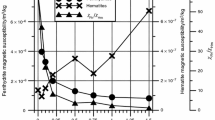Abstract
Ferrihydrite samples having Si/Fe molar ratios ranging from 0 to 1 were synthesized by the reaction of Fe2(SO4)3 and Na2SiO3 with NaOH to an equilibrium pH of 8.2. Hematite formed by incubating the ferrihydrite (Si/Fe molar ratios ≤0.05) at pH 12.5 and 91°C for 36 hr had a globular morphology. Hematite formed from Si-free ferrihydrite gave infrared (IR) bands at 548, 471, 397, and 337 cm−1, whereas, hematite formed from Si-containing ferrihydrite having 0.001 to 0.05 Si/Fe molar ratios gave broad IR bands at about 550, 450, and 330 cm−1. Ferrihydrite having Si/Fe molar ratios ≥0.10 did not transform to hematite following the aqueous-thermal treatment.
The ferrihydrite samples were thermally treated for 2 hr at consecutive 100°C intervals from 100° to 800°C. The Si-free ferrihydrite transformed at 300°C to poorly crystalline hematite. Transmission electron microscopic analyses indicated that the hematite consisted of aggregates of spheroidal particles of 20–80 Å cross sections. Broad IR bands were observed at 529 and 452 cm−1; however, after heating the sample to 800°C, the particle cross sections increased to about 150–600 Å, and additional IR bands were present at 378 and 325 cm−1. The differences in the IR patterns of hematite formed from ferrihydrite at 300° and 800°C were probably due to increases in particle size and aggregation and improved crystallinity of the hematite particles following the higher temperature treatment. The hematite formed by the thermal transformation of the ferrihydrite having a 0.01 Si/Fe molar ratio was also spheroidal, and IR vibrations were present at about 528 and 443 cm−1. An increase in the temperature of the thermal treatment, however, did not result in additional IR bands.
Differences in the IR vibrations of hematite formed during aqueous- and dry-thermal treatments of the ferrihydrite samples were probably due to differences in the particle size and morphology of the product. The Si content, due to its effect on particle size of the precursor and the prevention of sintering and particle growth of hematite, influenced the IR pattern of the product. Particle morphology and IR spectroscopy may therefore be useful indicators of the precursor of hematite and the conditions of hematite formation in soil.
Similar content being viewed by others
References
Barron, V., Rendon, J. L., Torrent, J., and Serna, C. J. (1984) Relation of infrared, crystallochemical, and morphological properties of aluminum-substituted hematite: Clays & Clay Minerals 32, 475–479.
Berreman, D. W. (1963) Infrared absorption at longitudinal optic frequency in cubic crystal film: Phys. Rev. 130, p. 2193.
Corjeno, J. (1987) Porosity evolution of thermally treated hydrous ferric oxide gel: J. Colloidal Interface Sci. 115, 260–263.
Feitknecht, W. and Michaelis, W. (1962) Über die Hydrolyse von Eisen (III)-Perchlorat-Lösungen: Heb. Chim. Acta 45, 212–224.
Fischer, W. R. and Schwertmann, U. (1975) The formation of hematite from amorphous iron(III) hydroxides: Clay Miner. 23, 33–37.
Herbillon, A. J. and An, J. T. (1969) Heterogeneity in sil-icon-iron mixed hydroxides: J. Soil Sci. 20, 223–235.
Hunt, J. M., Wisherd, M. P., and Bonham, L. C. (1950) Infrared absorption spectra of minerals and other inorganic compounds: Anal. Chem. 25, 1169–1174.
Matijevic, E. and Scheiner, P. J. (1978) Ferric hydrous oxide sols. III. Preparation of uniform particles by hydrolysis of Fe(III)-chloride, -nitrate, and -Perchlorate solutions: J. Colloid Interface Sci. 63, 509–524.
Ozaki, S., Kratohvil, S., and Matijevic, E. (1984) Formation of monodispersed spindle-type hematite particles: J. Colloid Interface Sci. 63, 509–524.
Rendon, J. L. and Serna, C. J. (1981) IR spectra of powder hematite: Effect of particle size and shape: Clay Miner. 16, 375–381.
Saraswat, I. P., Vajpei, A. C., Garg, V. K., Sharma, V. K., and Nam, P. (1980) Characterization and thermal trans-formation of ferric oxide hydrated gel: J. Colloidal Interface Sci. 73, 373–380.
Schwertmann, U. (1988) Some properties of soil and synthetic iron oxides in Iron in Soil and Clay Minerals, J. W. Stucki, B. A. Goodman, and U. Schwertmann, eds., Reidel, Dordrecht, The Netherlands, p. 893.
Serna, C. J. and Iglesias, J. E. (1986) Nature of protohae-matite and hydrohaematite: J. Materials Sci. Lett. 5, 901–902.
Serna, C. J., Ocana, M., and Iglesias, J. E. (1987) Optical properties of α-Fe2O3 microcrystals in the infrared: J. Phys. C: Solid State Phys. 20, 473–184.
Sidhu, P. S. (1988) Transformation of trace-element substituted maghemite to hematite: Clays & Clay Minerals 36, 31–38.
Vempati, R. K. and Loeppert, R. H. (1989) Influence of structural and adsorbed Si on the transformation of synthetic ferrihydrite: Clays & Clay Minerals 37, 273–279.
Vempati, R. K., Loeppert, R. H., and Cocke, D. L. (1990) Mineralogy and reactivity of amorphous Siferrihydrite: Solid State Ionics (in press).
Wilson, M. J., Russell, J. D., Tait, J. D., Clark, D. R., Fraser, A. R., and Stephen, I. (1981) A swelling hematite/layer silicate complex in weathering granite: Clay Miner. 16, 261–277.
Author information
Authors and Affiliations
Rights and permissions
About this article
Cite this article
Vempati, R.K., Loeppert, R.H., Sittertz-Bhatkar, H. et al. Infrared Vibrations of Hematite Formed from Aqueous- and Dry-Thermal Incubation of Si-Containing Ferrihydrite. Clays Clay Miner. 38, 294–298 (1990). https://doi.org/10.1346/CCMN.1990.0380308
Received:
Accepted:
Published:
Issue Date:
DOI: https://doi.org/10.1346/CCMN.1990.0380308




